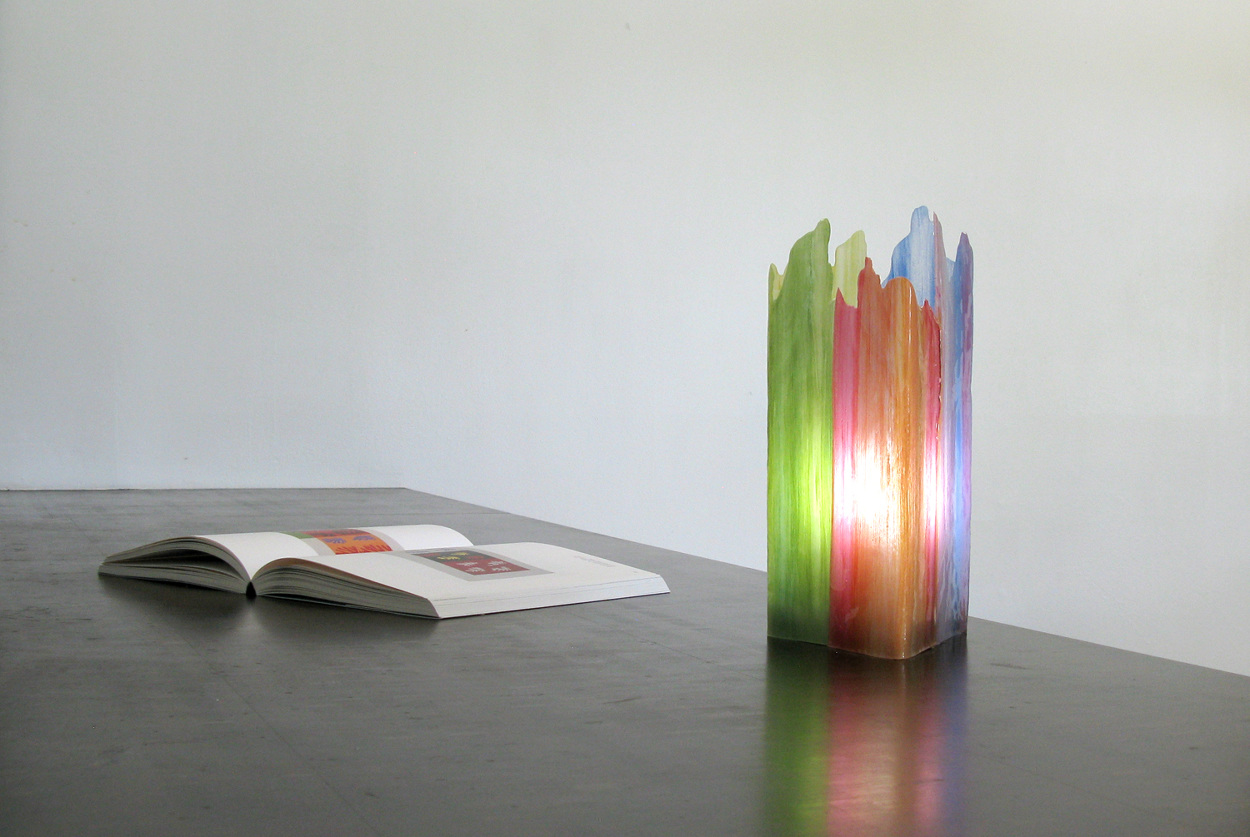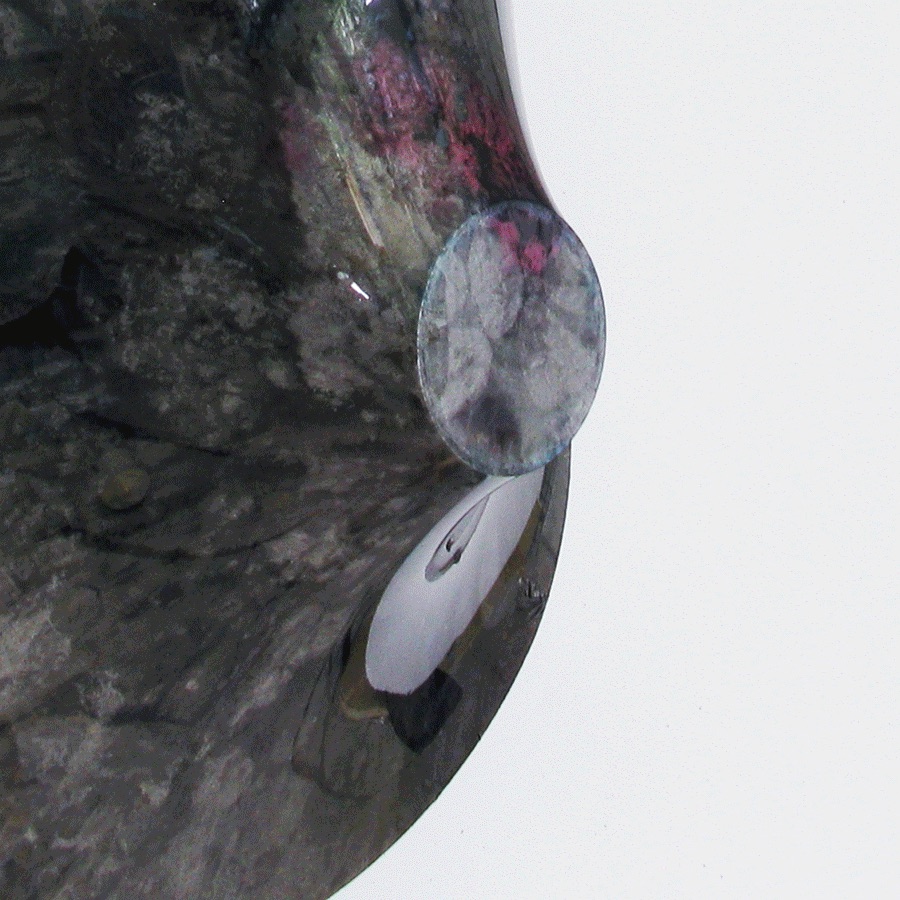Taeg Nishimoto–The work of a material polymath
by Abigail Ward
Textured surfaces, shapely undulating forms, and organic, free-flowing patterns. A space divider made of wood tiles laid in a multi-directional form; captivating globular and resinous light fixtures; outdoor play furniture made of concrete canvas and several diverse site-specific installations: This is the work of Taeg Nishimoto–architect, designer, and educator.
With a wide-ranging and inspired material portfolio behind him, including those as varied as lace, concrete, bioplastic, resin, Tyvek, natural fabric and charred wood, it would be easy to assume that Taeg Nishimoto is blessed with a background and education in material research. In reality, however, he has trained in architecture, pursues an interest in design products, and has an undeniable knack for material exploration.
It is fair to say that Nishimoto has flourished in each of these realms, leading him to be easily described as a multitalented polymath. It is the union of disciplines that has lead Nishimoto’s work in an intriguing and multi-dimensional direction.
The Nuclei Lamp by Taeg Nishimoto boasts a warping surface made of two layers of polyolefin film (or shrink wrap) within which are sandwiched a combination of paints of various fluidity. The application of heat and light on the film creates unexpected interactions among the paints as well as with trapped air inside the layers, leading to the visual effects seen above.
Often, one finds that his work appears to be one thing but turns out to be another. One way in which this occurs is through the clever implementation of materials. What would appear to be made out of paper is in fact made out of cast concrete. An object one assumes to be cloaked in free-flowing silk, is in fact molded from cornstarch-based bioplastic. Upon the addition of a light source, a pool of inky black patterns–seen in one of Nishimoto’s works–transforms into a swirling mass of color.
Painterly Spectrum Resin by Taeg Nishimoto is a table lamp made of epoxy resin cast on the surface of parchment paper, on which color strokes are applied beforehand using latex paint.
Concrete Canvas Play Furniture, By Taeg Nishimoto is made from Concrete Canvas, placed on a form-shaping structure. The forms are intended to provoke playfulness in their interaction with children.
Absorbing and stimulating, the multi-faceted nature of Nishimoto’s work invites the observer to ‘lean in'–asking each spectator to hover for a moment longer, examining, questioning and discerning each piece.
As part of our ongoing ‘Material as Object’ series, MaterialDriven recently spoke with Taeg Nishimoto. Through this interview, we delved into his journey as a designer and material-explorer, as well as the motivations and processes behind his works. Finally, we discussed with him one of his most recent projects–the Nuclei Lamp, seen at Paris Design Week, at Maison&Objet, as a part of the curated exhibition “Meet My Project.” Here is our conversation with Taeg:
MD: You practice and teach as an architect, in addition to your work as a designer, where you work with an extensive repertoire of contemporary materials. How do these two parallel practices feed into your work with objects, most recently such as the Nuclei Lamp?
TN: For me, these different activities are all organically related. The exploration of different materials with the possible conclusion of a designed object is, for me, a form of research and demonstration. It’s not necessarily the particularities of the result that interest me most, but the process that takes place during the making. I think there is very little difference between designing buildings and designing objects, especially with regards to the exploration and integration of materials today.
The Nuclei Lamp boasts a warping surface made of two layers of polyolefin film (or shrink wrap) within which are sandwiched a combination of paints of various fluidity. In the unlit state, the lamp appears dark and inky as seen above.
The application of heat and light on the film creates unexpected interactions among the paints as well as with trapped air inside the layers, leading to the visual effects seen below.
MD: How does the design process begin for you typically?
TN: It varies. Sometimes a project can originate with the intent to explore a particular use or application. Other times, it can be entirely my desire to explore a certain material, such as bioplastic. From each of these, the process can then evolve, resulting in the creation of a variety of design objects. Essentially, I work to find links between the material properties, the process of using or manipulating the material, and the desired application, all while connecting these in the most interesting, engaging and aesthetically pleasing way.
Undulae by Taeg Nishimoto is a series of table and pendant lamps made of cornstarch-based bioplastic tubes. Using the characteristics of shrinking and undulating when bioplastic is in the drying process, the formal manipulation is left for each tube to develop itself. Below is seen the process of casting and drying the bioplastic.
MD: In your work, you utilize an array of materials–from resin to plastic, to concrete, to everyday elements such as shrink wrap and paint. Are there materials you would like to explore in the future, or even those which you shy away from entirely (and why)?
TN: Materials that have an obvious endpoint are not of much interest to me. I’m often drawn to the kinds of substances that are spontaneous. Those that can be ‘disrupted’ during the making process. These substances can have very specific characteristics, but do not exhibit a predetermined final outcome. For those that do, however, there is the need to reflect on how such a predetermined or preconditioned state originates. I feel that bio-based materials are a good example of this, and it is for this reason that I would like to explore such substances in the future.
Undulae by Taeg Nishimoto is a series of table and pendant lamps made of cornstarch-based bioplastic tubes. This series pursues Nishmoto's interest in bio-based materials as spontaneous alternatives to more conventional materials.
MD: In reference to the making of the Nuclei Lamp–one of your most recent projects–how did you begin layering shrink wrap and paint together (an unexpected combination of materials), and what experiments and processes were involved?
TN: The process began with my interest in the technique of ‘Frottage,' a mark-making process where a rubbing is taken from an uneven surface. In the beginning, I was interested in the fact that this method creates a kind of unique two-dimensional visual texture. I carried out this practice using many different surfaces and mediums, all while trying to produce a mark that still carries the association of the subjects they were taken from. The transparent plastic film was one of the surfaces I used.
Above: The exploration process for the Nuclei Lamp by Taeg Nishimoto: Layers of shrink wrap (polyolefin film) hold between them liquid paint, and carry textures impressed upon them, inspired by the technique of 'Frottage'. Below: An image of the film and color test for the Nuclei Lamp at a small scale.
In conjunction with this, I realized that color presented in liquid forms, such as paint, can generate specific visual associations. Though not necessarily identifiable, these possible visual states often seem familiar to us. We have many situations where the liquid state of color reminds us of something, like microscopic or telescopic images. The final application emerged as a result of going through these explorations and responding to what happened in the process.
MD: You mentioned that the shape of the external shell for the Nuclei Lamp is based on the process of cell division. How did this become an inspiration for the lamp?
TN: In my process, there is a moment when the use of materials and the final applications are almost set. At this point, I tend to search for the associations available to me in terms of form. It was during this stage of the development that I made the connection between cell division and the concepts and ideas that already surrounded the Nuclei lamp.
The Nuclei Lamp boasts a warping surface made of two layers of polyolefin film (or shrink wrap) within which are sandwiched a combination of paints of various fluidity. In the unlit state, the lamp appears dark and inky as seen to the left and right. The application of heat and light on the film however creates unexpected interactions among the paints as well as with trapped air inside the layers, leading to the visual effects seen in the centre of this image.
Rather than sketching the form first, and then finding a way to make that form three-dimensionally, the form comes last, as a kind of reflexion. An analogy I like to use is that of oak trees. All oak trees, for example, are distinctly oak trees, each is grown from an acorn, and each requires light, water, and food to develop. Despite this, no two fully grown trees are the same. In this sense, just like everything in nature, for me the form is always a kind of prototype, it is open-ended rather than a fixed image.
MD: What are you working on next? Are there collaborations (with other disciplines or practitioners) that you would like to see for your work in the future?
TN: I have just completed a series of side tables with transparent legs, using two types of plastic, investigating and exploiting their material differences. I haven’t focused on a particular application or collaboration yet, I am, however, interested in finding ways in which bio-based materials can become part of my exploration. I appreciate efforts made by people who are redefining familiar objects through exploring these elements and their process.
im Wald is a series of side tables by Taeg Nishimoto, made of transparent legs of two types of plastic (heat-resistant polyester sheet, and heat-responsive PETG tubes) and a combination of differently sized disk tops in black. It is an exploration into the making of visual as well as tactile textures from transparent plastic and their effects.




















